#japan folklore
Explore tagged Tumblr posts
Text










2024 Yokai Night Parade- TOEI studio park, Kyoto Japan
#occult#folklore#gothic#folk horror#goth#japan#japan folklore#japanese#horror#folkhorror#spooky#spooky season#halloween#masks#mask#monster#ghost#ghosts#haunted#haunting#cyclops#goth aesthetic#goth vibes#macabre#black and white#black and white photography#street photography#japanese yokai#travel
2K notes
·
View notes
Text
𐙚 Hachishakusama 𐙚

Hachishakusama, also known as "Eight Feet Tall" (八尺様, Hachishakusama), is a compelling urban legend from Japan, known to haunt and terrify children.
Hachishakusama stands at a towering eight shaku, about 240 cm or 7 feet 10 inches. She is often depicted wearing a long, flowing white dress or burial kimono. Sometimes, she is described wearing a wide-brimmed hat. Her face is usually obscured, adding to her mysterious and ominous presence. She mainly resembles a lady.
She emits a deep, masculine voice that repeats the sound "Po... Po... Po..." in a slow, rhythmic manner. This sound is often the first sign of her presence.
Hachishakusama typically targets children, usually those around the ages of 8 to 13. The reasons for her preference for children are unclear, but it adds a layer of dread to the legend. Once she has chosen a victim, she begins to stalk them relentlessly. The child and those around them might notice her figure lurking in the distance, her voice growing closer over time. Children who have seen or heard her are marked for abduction. The legend states that once marked, the child has only a few days before Hachishakusama takes them away.
Origin of the Legend
The legend of Hachishakusama is a modern creation that has gained popularity through the internet, particularly on Japanese forums and horror websites. It is a part of the larger genre of urban legends and ghost stories that blend traditional Japanese folklore with contemporary fears.
Protective Measures and Rituals
Surrounding the child with bowls of salt and placing protective charms (omamori) around their living space can help ward off Hachishakusama. The salt is believed to purify and create a barrier against evil spirits.
The child may be confined in a room with religious symbols, such as Buddhist sutras or Shinto talismans. These symbols are believed to provide protection by creating a sacred space that evil spirits cannot penetrate.
Moving the child to a distant location, preferably outside of Japan, is considered one of the most effective ways to break the curse. The belief is that Hachishakusama's influence weakens with distance. However, the minute they step back into Japan, they are to be abducted.
Cultural Impact and Interpretations
Hachishakusama has appeared in various forms of media, including horror manga, video games, and creepypasta stories. Her story has been adapted and retold in numerous ways, cementing her place in contemporary folklore.
The legend taps into deep-seated fears, such as the fear of the unknown, the supernatural, and the vulnerability of children. It also reflects societal concerns about the safety of children and the ever-present threat of danger in a seemingly safe environment.
Hachishakusama shares similarities with other supernatural figures in folklore, such as the Slender Man from Western urban legends. Both are tall, mysterious figures that target the young and evoke a sense of pervasive dread.
Popular Story Example
A well-known version of the Hachishakusama story involves a young boy visiting his grandparents in a rural village. During his stay, he encounters Hachishakusama in the garden, hearing her eerie "Po... Po... Po..." sound. His grandparents, recognizing the signs, quickly take protective measures, isolating him in a room surrounded by salt and religious charms. Despite their efforts, the boy feels her presence growing stronger. Ultimately, he is sent away to live with relatives far from the village, breaking the curse. This story highlights the combination of traditional protective practices and the ultimate need for distance to escape her grasp.
BEWARE THE WRATH OF THE HACHISHAKUSAMA
and also look at my cute drawing i did of her during making this :3
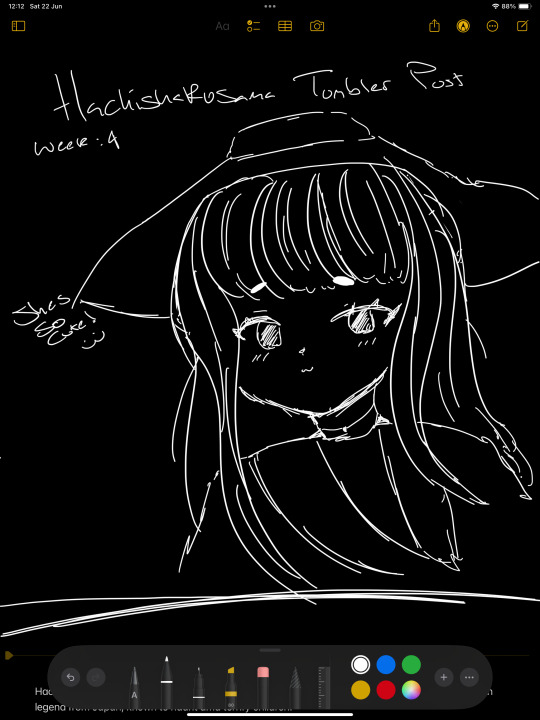

12 notes
·
View notes
Text
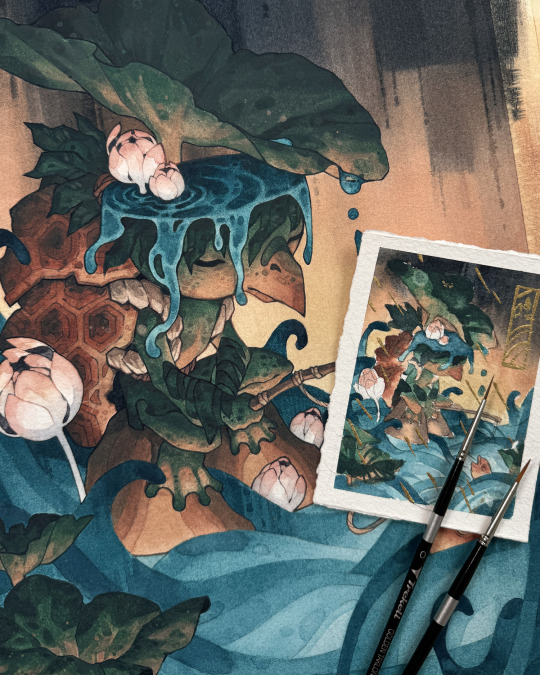
work in progress of this little kappa #brbchasingdreams
prints | tutorials
#brbchasingdreams#art#illustration#drawing#painting#artists on tumblr#watercolor#traditional art#artist#sketch#kappa#yokai#demon#japanese#japan#asian art#art style#folklore#folk take#creature#fantasy#wip#exhibition#my art
1K notes
·
View notes
Text
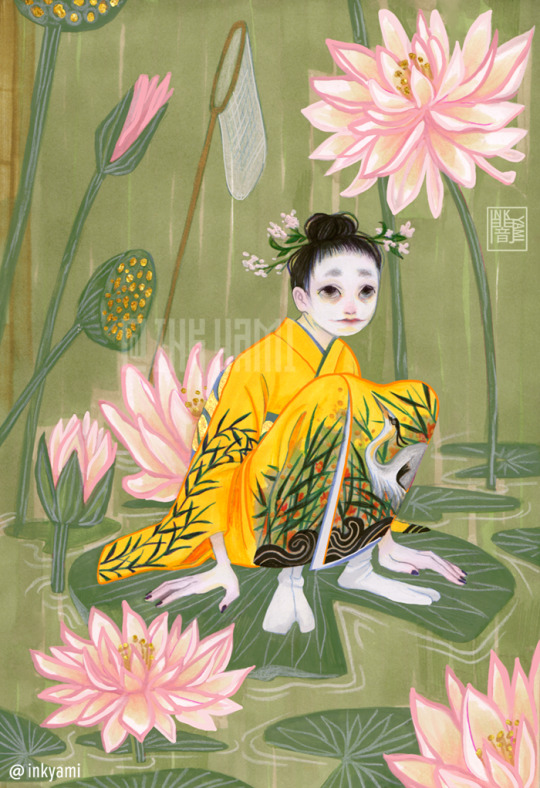
Kaeru nyōbō (蛙女房) — "frog wive", a shapeshifting character in Japanese folklore. The frog turns into a woman in order to marry a human man, but retains some of her froggy qualities — Kaeru nyōbō is very fragile, small, and is unable to do heavy work due to her little strength. The life with her can be perfectly ordinary and peaceful, unless the curiosity of a husband & family discovers her true nature, and she hops away.
The stories about frog wives exist all over Japan with some variations of the plot. The motive itself — of a girl "with a secret" and a family ruined by prying into it — seems to be extremely popular in Japanese folklore in general.
Twitter | VK | INPRNT | Leave a tip
#artists on tumblr#mermay#-ish#japanese folklore#kaeru nyobo#folklore#japan#its wednesday my dudes#and IT IS A COINCIDENCE#inkyami researches#its been a LONG while since I added to my series on Japan#my russian blog audience is having a field day with Tsarevna the Frog comparisons)
683 notes
·
View notes
Text

Tengu are a medium sized, arboreal, humanoid inhabiting the lush mountain and forest terrain of Nippon . Communal and highly social, Tengu live in large extended family units with a matriarch or patriarch at the helm.
Sexual dimorphism is subtle. With males and females being roughly the same size, color and shape. While males and females both posses large noses, dominant elder males have been recorded having noses that extended beyond their stomachs. Such a nose is incredibly attractive to highly selective females.
While relatively docile in nature, if provoked, they can be quite dangerous, using their large fangs, claws and brute to wield fatal blows. This ferocity is especially displayed during territory disputes amongst rival clans.
While relatively high on the food chain Tengu are still susceptible to predation. Kitsune, Ryu and at times even Oni will actively hunt adult Tengu. However it is the young pups who are most susceptible during their nascent voyages away from mom.
While incredibly nimble in the trees, Tengu also are able to fly. Due to their robust bodies they can only fly for short distances but can cover vast distances despite this.
An eclectic diet, Tengu are opportunistic eaters. With a diet ranging from fruits and nuts to Kappa chicks and small rodents.
Due to their high intelligence Tengu are known tricksters who will regularly steal clothing, food and supplies from lost travelers.
#concept art#creature design#fantasy art#creature concept#concept design#monster#fantasy#speculative biology#tengu#japan#yokai#japanesemythology#fairy#conceptart#creaturedesign#bestiary#artistoninstagram#monstergram#magicthegathering#dungeonsanddragons#digitalart#fantasyart#mythologicalcreatures#folklore#sketch
695 notes
·
View notes
Text

GA SHA DO KU RO
173 notes
·
View notes
Text

Shiro’uneri, the 250th Known One.
#so glad to come to 1000th chimeras !!!!#This is what happens when you let a mop rot for 100 years#old objects that become yokais are my favorite types#my 1000th chimera is a yokai to remind the Parade of 100 Demons#yokai#Shiro’uneri#mop#chimera#monster#ink#bestiary#the Known Ones#creature design#1000#aer 4#octem 125#folklore#Japan#Asia#fish#jellyfish#dog#komondor#nudibranch#sea slug
261 notes
·
View notes
Text









Kwaidan (1964)
Directed by Masaki Kobayashi
Cinematography by Yoshio Miyajima
#art#art history#artists on tumblr#aesthetic#film photography#beautiful photography#film#movie#cult film#kwaidan#kobayashi#masaki kobayashi#japan#japanese art#japanese#japanese culture#japanese language#painting#japanese movie#japanese film#japanese folklore#japanese flower#japanese fashion#asian art#asian movie#asian film#60s art#60s#60s movies#60s film
381 notes
·
View notes
Text
Proof that history repeats itself:

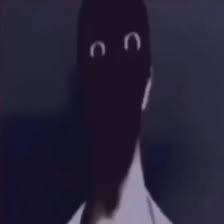
#umibozu#the mandela catalogue#mandela catalogue#history repeats itself#meme#proof#memes#japanese#Japan#analogue horror#japanese folklore#japanese mythology#mythology#alex kister#yokai
92 notes
·
View notes
Text

As de Bâtons. Art by Matthew Meyer, from Tarot Yōkai.
ワンドのエース SEIRYŪ Seiryu is a long-tongued dragon, one of the four shijin, the symbols of Taoism. It represents the planet Jupiter, benevolence, and creativity. In the minor arcana, the Ace of Wands speaks of our potential. We are open to new opportunities and creative inspirations. Upright: inspiration, new opportunities, potential. With the Ace of Wands, we are called to follow our passions: it is time to make room for our creative energies and embark on the path of a new project. The Ace of Wands can also represent significant inner or personal growth. Reversed: lack of direction, distractions, emerging ideas. Reversed, this card suggests that new ideas are coming but we do not yet know how to organize or shape them. It can also indicate that we have difficulty identifying our purpose in life, and that we struggle to find creative stimulation. Finally, this card can speak of a certain impatience, especially if we are already actively pursuing a project.
64 notes
·
View notes
Text


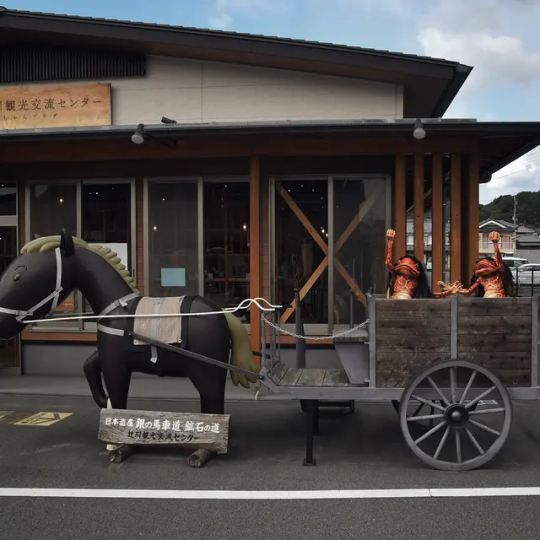




Fukusaki, a small town in Hyogo Prefecture, is well-known for its connection to the legendary kappa, mischievous water creatures from Japanese folklore. While the famous kappa statue in the pond is a centerpiece, the town features several other kappa statues scattered throughout, each reflecting their unique and playful mythology. According to legend, kappa are curious, often mischievous beings who dwell in rivers and ponds, with a peculiar reputation for attempting to extract a mythical organ called the shirikodama from humans. This organ, believed to reside in the rectum, is said to contain a person’s soul or vital energy, and the kappa's fascination with it has made them both feared and fascinating figures in Japanese culture. Fukusaki celebrates this curious mythology with these statues, blending whimsy with folklore in a way that captivates visitors.- Fukusaki, Japan
#kappa#folklore#gothic#occult#folk horror#goth#folkhorror#horror#monsters#monster#spooky#street art#street photography#lizard#lizard man#cryptid#japan folklore#japanese yokai#japan#Japanese#Fukusaki
91 notes
·
View notes
Text
How a mythical catfish became the symbol of the Japanese working class: the Namazu

In 1855, a colossal earthquake hit the city of Tokyo, which at the time was called Edo. The clean-up and rebuilding efforts of this disaster coincided with a steep rise in pamphlets, booklets and prints featuring a giant catfish: this is because in Japanese mythology, the giant catfish Namazu is the great bringer of earthquakes. It was also called Jishin no Uo, the Earthquake Fish.
The Namazu is a giant, monstrous catfish who lives deep within the Earth. When he trashes about, earthquakes plague the lands above and cause great suffering to humans. The Namazu is usually depicted as either a colossal catfish or a humanoid creature with the head of a catfish but still wearing human clothes. In some cases, it is portrayed as a dragon with the head of a catfish.
The Kashima deity – who is worshipped at the Kashima shrine in Ibaraki prefecture – managed to defeat the monster and keeps it under control with his sword. Supposedly, this god is still there, and whenever he falters or lowers his guard, or when he falls asleep, the Namazu is able to thrash around it and cause an earthquake. In another version, the monster is pinned under a giant rock, the top of which (the ‘Kanameishi’) is visible at the Kashima shrine. It is believed that the god pushes down on this stone to prevent his enemy from moving.

And yet, despite this calamitous catfish being a bringer of suffering and despair, there are texts from this period that praise the Namazu and welcome it. Some of these prints feature the creature singing a ‘yo-naoshi chobokure’ song, which consoles the hearer by telling them to ‘rejoice and be happy, for you will become rich overnight!’ In some images, the Namazu is even vomiting gold and silver coins while fighting the god who restrains it.
This association between earthquakes and wealth seems contradictory at first, but there is a reason for it: those who have the largest properties have more to lose in an earthquake. The manors of nobles and rich people, as well as the storehouses of wealthy merchants, were thoroughly destroyed in the disaster. In fact, by coincidence, residences of the elite seemed to have been disproportionally damaged whereas commoner neighbourhoods got off with (relatively!) few casualties.
More importantly, the rebuilding efforts allowed a massive redistribution of wealth to those who were actually rebuilding: the carpenters, plasters, roofers and other workers of Edo reaped record profits in the years following the great quake, as their trades were in higher demand than ever before. Similarly, merchants who dealt in construction materials saw demand for their products skyrocket. In an ironic twist of fate, the Namazu became a political symbol of the working class, and of social rectification.

In fact, some illustrators in this era were less subtle and made images (now in the Tokyo and Fujisawa University collections) of the Namazu violently shaking the rich until they vomited or even defecated money. I find this really interesting because these are quite literally political cartoons, just from a distant time and place. In one of the prints from the Fujisawa collection, the text tells how the rich suffered from ‘choja kane no byo’ or ‘money disease’ and the Namazu, now hailed as an earthquake god, forcibly takes away their hoarded wealth and distributes it to the builders. As far as allegories go, you can’t get less subtle than that.
Nevertheless, the Namazu remained a symbol of earthquakes and that association still exists today. The Pokémon Whiscash, for example, is based on the mythical Namazu. In Legend of Zelda: A Link to the Past, a giant catfish gives the player the ‘quake medallion’. The Namazu remains a somewhat common sight in Japanese pop culture.
Sources: Ouweland, C., 1964, Namazu-e and their themes: an interpretative approach to some aspects of Japanese folk religion, Brill Archive, 271 pp. Smits, G., The Ansei Edo Earthquake and Catfish Prints, essay, University of British Columbia. Steele, M. W., Apocalypse Now: an alternate view of the Bakumatsu years, essay, University of British Columbia. (image 1: An 1855 woodblock print depicting the Namazu fighting the sword wielding god while the rich pour money onto the working class. Image taken from World History Encyclopedia) (image 2: an 1855 woodblock print depicting the Namazu, dressed as a monk, chanting the nenbutsu in an attempt to appease the people who died in the earthquake, as their souls look down from above. Source: Hachiro Yuasa Memorial Museum) (image 3: the Namazu, now with a human body, is attacked by courtesans and rich merchants while construction workers (dressed in black) attempt to stop them. Image source: University of British Columbia Library)
#Japanese mythology#mythical creatures#catfish#monsters#creatures#world mythology#folklore#folktales#Japan
66 notes
·
View notes
Photo
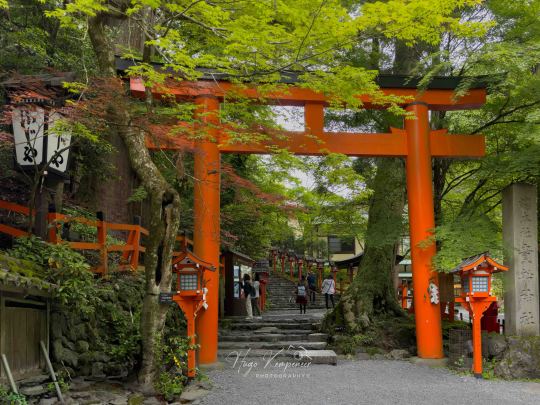
Kibune, nestled in the mountains just north of Kyoto, is special in Japanese folklore and history. This enchanting village is known for its magical atmosphere and mysterious legends passed down through generations.
95 notes
·
View notes
Text

Kitsune Twisted Glisten 🦊🎀🖤✨
#roblox#dandy's world#dandys world#twisted glisten#glisten#finn#pebble#twisted boxten#boxten#kitsune#japan#japanese#folklore
26 notes
·
View notes
Text




The KaiKai Yōkai Festival's Great Night Parade at the TOEI Kyoto Studio Park. Kyoto, Japan.
41 notes
·
View notes
Text
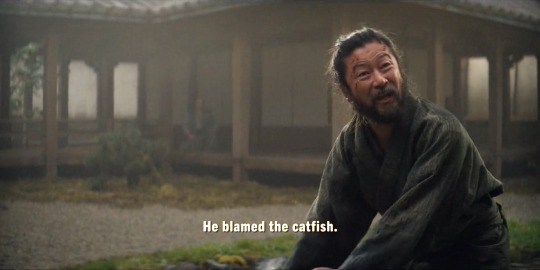
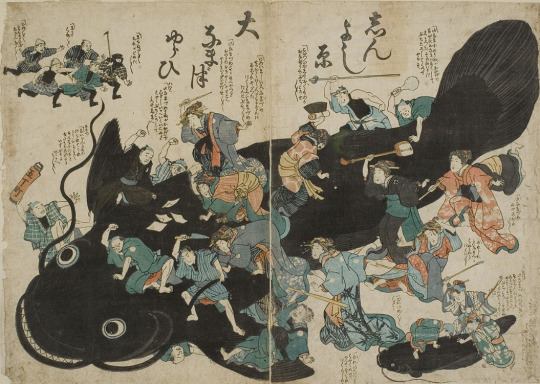
Fun Trivia : Did you know Catfish exist in Japanese mythology called Namazu?
Legend has it that there was a giant underground catfish which causes earthquakes and lives under the islands of Japan.
It was believe to be have been spotted at Lake Biwa and there is an Otsu-e painting depicting the creature in Otsu, Shiga Prefecture.
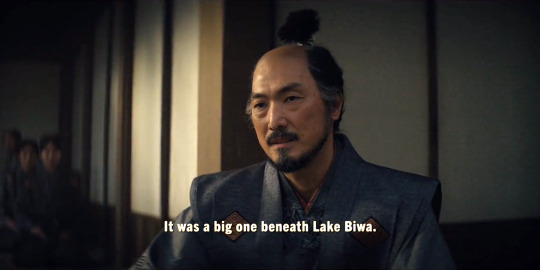
So the producers of Shogun knew what they were doing when they created this scene of Yabu and Ishido about the supersition.
It happened when an eel fisherman reportedly spotted unusual active catfish in a river, followed by an earthquake.

Namazu was considered by the people to be "Yanaoshi Daimyojin" (God of World Rectification), an avenger of social injustice.
They believed the rich hoarded their wealth but were disgorged due to earthquake and redistribute to the people in rebuilding efforts.

Although Ishido repeatedly tries to deny it but you can tell that he is actually terrified knowing that his recent actions were "immoral".
Being born a peasant, he would believe the Namazu but pretend not to care to show his followers that he is not a peasant but a Samurai.
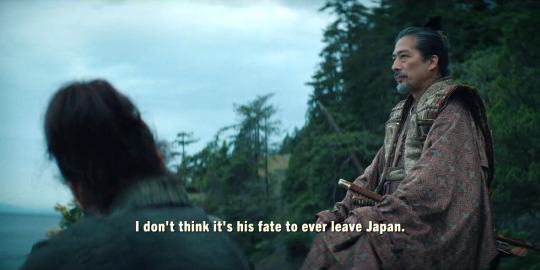
And the fact that Toranaga survived the earthquakes thrice implies that the Gods or Namazu have favored him over Ishido.
Toranaga probably believe in it to, thinking that Anjin is sent by the Gods to protect him. One reason he decides to keep him by his side.

Toranaga, being an opportunist and strategist, takes the earthquake as an omen that those who follow Ishida would be doomed.
Not only is he now a "rebel", being abandoned by the Taiko's heir and consort, Ochiba but also abandoned by the Gods.

Japanese religion and folklore brim with an astounding variety of deities and creatures, products of a polytheistic belief.
Richly varied in appearance and behaviour, this pantheon laid the groundwork for the Kaiju culture of modern era like Godzilla.

Some believe Godzilla to be simply a demonic but some believe it to be a wrath of the Gods sent to punish humans, like the Namazu.
A reason that I've always loved watching Japanese films is that there's always a mix of legends which adds to the mystery.
#shogun#shogun fx#shogun 2024#catfish#namazu#japanese folklore#japanese mythology#japan#japanese culture#kaiju#lake biwa#otsu#shiga prefecture#godzilla#period drama#jidaigeki
90 notes
·
View notes